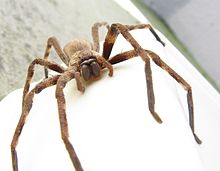| Huntsman spiders Temporal range:
| |
|---|---|

| |
| Palystes castaneus, showing sparassid pattern of eyes in two rows of four, with the robust build and non-clavate pedipalps of a female | |
| Scientific classification | |
| Domain: | Eukaryota |
| Kingdom: | Animalia |
| Phylum: | Arthropoda |
| Subphylum: | Chelicerata |
| Class: | Arachnida |
| Order: | Araneae |
| Infraorder: | Araneomorphae |
| Family: | Sparassidae Bertkau, 1872[1] |
| Diversity[2] | |
| 88 genera, 1363 species | |

| |
Huntsman spiders, members of the family Sparassidae (formerly Heteropodidae), catch their prey by hunting rather than in webs.[3] They are also called giant crab spiders because of their size and appearance. Larger species sometimes are referred to as wood spiders, because of their preference for woody places (forests, mine shafts, woodpiles, wooden shacks). In southern Africa the genus Palystes are known as rain spiders or lizard-eating spiders.[4] Commonly, they are confused with baboon spiders from the Mygalomorphae infraorder, which are not closely related.
More than a thousand Sparassidae species occur in most warm temperate to tropical regions of the world, including much of Australia, Africa, Asia, the Mediterranean Basin, and the Americas.[5]
Several species of huntsman spider can use an unusual form of locomotion. The wheel spider (Carparachne aureoflava) from the Namib uses a cartwheeling motion which gives it its name, while Cebrennus rechenbergi uses a handspring motion.
- ^ Cite error: The named reference
WSC_g90was invoked but never defined (see the help page). - ^ Cite error: The named reference
WSC_statswas invoked but never defined (see the help page). - ^ Saaristo, Michael I. (2010). "Araneae". In Gerlach, Justin & Marusik, Yuri M. (eds.). Arachnida and Myriapoda of the Seychelles islands. Siri Scientific Press.
- ^ Norman Larsen. "Palystes (rain spiders, lizard-eating spiders)". Iziko Museums of Cape Town. Biodiversity Explorer. Retrieved 2010-05-02.
- ^ Geoffrey K. Isbister & David Hirst (2003). "A prospective study of definite bites by spiders of the family Sparassidae (huntsmen spiders) with identification to species level". Toxicon. 42 (2): 163–171. doi:10.1016/S0041-0101(03)00129-6. PMID 12906887.